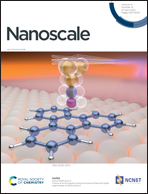InSe:Ge-doped InSe van der Waals heterostructure to enhance photogenerated carrier separation for self-powered photoelectrochemical-type photodetectors†
Abstract
Two-dimensional (2D) van der Waals (vdW) materials with tunable heterostructures and superior optoelectronic properties have opened a new platform for various applications, e.g., field-effect transistors, ultrasensitive photodetectors and photocatalysts. In this work, an InSe/InSe(Ge) (germanium doped InSe) vdW heterostructure is designed to improve the photoresponse performance of sole InSe in a photoelectrochemical (PEC)-type photodetector. Photoelectrochemical measurements demonstrated that this heterostructure has excellent photoresponse characteristics, including a photocurrent density of 9.8 μA cm−2, a photo-responsivity of 64 μA W−1, and a response time/recovery time of 0.128 s/0.1 s. Moreover, the measurements also revealed the self-powering capability and long-term cycling stability of this heterostructure. The electronic properties of the prepared pure and Ge-doped single crystals unveiled a negative and temperature-independent thermoelectric power and temperature-activated resistivity. The negative character of dominating charge carriers was confirmed by Hall measurements, which corroborated by electrical resistivity revealed a carrier concentration below ∼1015 cm−3 and an electron mobility of ∼500 cm2 V−1 s−1 in Ge-doped crystals. Additionally, the Mott–Schottky model explored the mechanism of charge transfer and enhanced PEC performance. Band bending at the InSe/InSe(Ge)–electrolyte interface benefits the separation and transformation of photogenerated carriers from the heterostructure to electrolyte due to the tunable energy band alignment. These results indicate that the InSe/InSe(Ge) vdW heterostructure is promising for PEC-type photodetectors, which provide a novel way to utilize 2D vdW heterostructures in optoelectronics.



 Please wait while we load your content...
Please wait while we load your content...